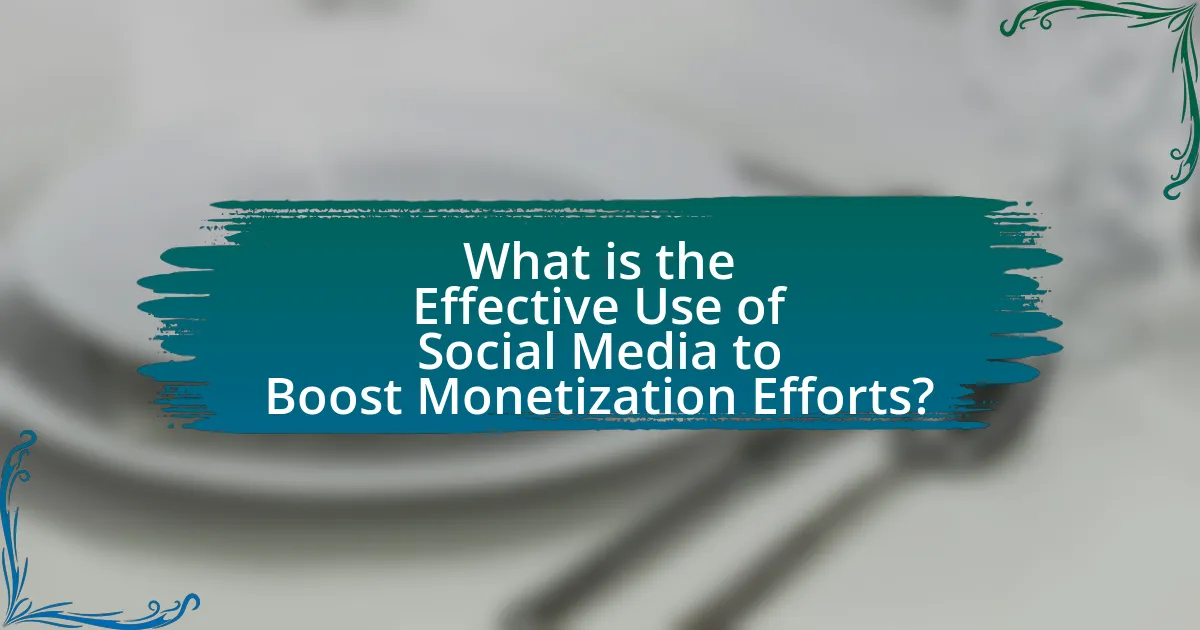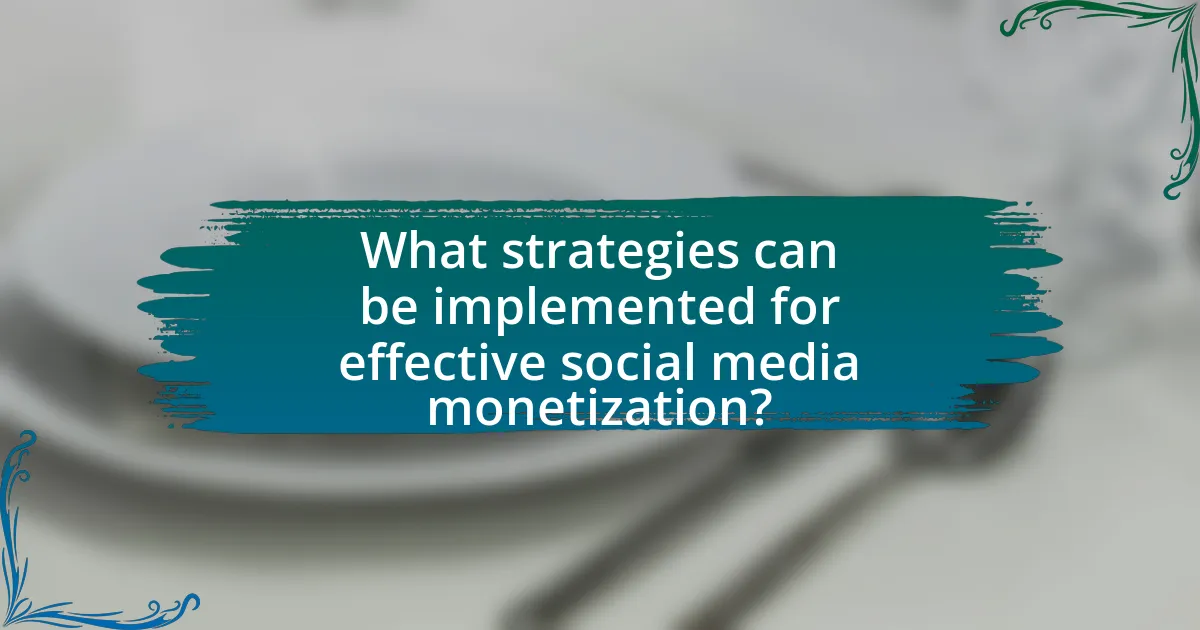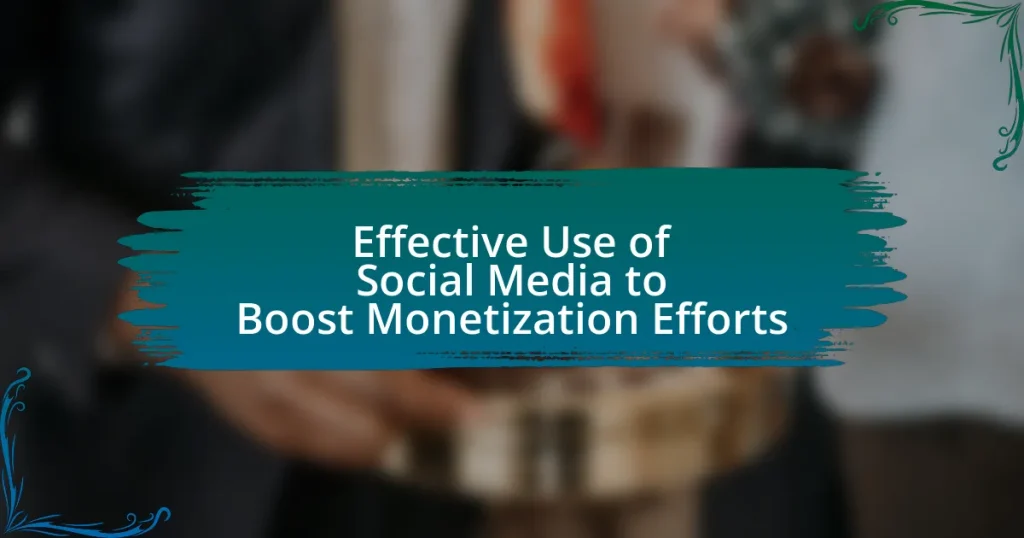The article focuses on the effective use of social media to enhance monetization efforts for businesses. It outlines strategies such as targeted advertising, subscription models, and e-commerce integrations that leverage user engagement and analytics to drive sales. Key features supporting monetization include audience engagement, targeted ads, and analytics tools, while various platforms offer distinct monetization capabilities. The article also addresses trends influencing social media monetization, the impact of audience engagement on sales, and best practices for creating effective ads and content. Additionally, it discusses metrics for measuring success and common challenges faced in social media monetization.

What is the Effective Use of Social Media to Boost Monetization Efforts?
The effective use of social media to boost monetization efforts involves strategically leveraging platforms to engage audiences, drive traffic, and convert interactions into sales. Businesses can achieve this by creating targeted content that resonates with their audience, utilizing analytics to refine strategies, and employing advertising tools to reach potential customers. For instance, a study by Hootsuite found that 73% of marketers believe their efforts through social media marketing have been “somewhat effective” or “very effective” for their business, highlighting the importance of a well-planned social media strategy in driving revenue.
How can social media platforms enhance monetization strategies?
Social media platforms can enhance monetization strategies by implementing targeted advertising, subscription models, and e-commerce integrations. Targeted advertising allows platforms to leverage user data to deliver personalized ads, increasing engagement and conversion rates; for instance, Facebook generated $84.2 billion in ad revenue in 2020, showcasing the effectiveness of this approach. Subscription models, like those used by platforms such as Patreon, provide creators with a steady income stream while fostering community engagement. Additionally, e-commerce integrations, exemplified by Instagram’s shopping features, enable direct product sales, streamlining the purchasing process for users and driving revenue growth. These strategies collectively optimize monetization efforts by aligning user experience with revenue generation.
What are the key features of social media that support monetization?
Key features of social media that support monetization include targeted advertising, user engagement, and analytics tools. Targeted advertising allows businesses to reach specific demographics based on user data, enhancing ad effectiveness; for instance, Facebook’s advertising platform enables advertisers to target users by age, interests, and behaviors, resulting in higher conversion rates. User engagement features, such as likes, shares, and comments, foster community interaction, which can lead to increased brand loyalty and sales; studies show that brands with high engagement rates see a 20-40% increase in revenue. Finally, analytics tools provide insights into user behavior and campaign performance, allowing businesses to optimize their strategies; platforms like Instagram and Twitter offer detailed analytics that help brands refine their marketing efforts, leading to improved ROI.
How do different social media platforms vary in their monetization capabilities?
Different social media platforms vary significantly in their monetization capabilities, primarily through advertising models, subscription services, and e-commerce integrations. For instance, Facebook and Instagram utilize targeted advertising based on user data, allowing businesses to reach specific demographics effectively; in 2022, Facebook generated approximately $113 billion in ad revenue, showcasing its robust monetization strategy. In contrast, platforms like YouTube offer monetization through ad revenue sharing with content creators, where creators can earn money based on views and engagement; in 2021, YouTube paid out over $30 billion to creators, indicating a strong incentive for content production. TikTok, on the other hand, has introduced features like TikTok Shopping, enabling direct sales through the app, which reflects a shift towards integrating e-commerce within social media. Each platform’s unique approach to monetization caters to different user behaviors and business needs, illustrating the diverse landscape of social media monetization.
Why is social media important for monetization in today’s digital landscape?
Social media is crucial for monetization in today’s digital landscape because it provides businesses with direct access to a vast audience, enabling targeted marketing and engagement. Platforms like Facebook, Instagram, and Twitter have billions of active users, allowing brands to reach specific demographics effectively. According to Statista, as of 2023, there are over 4.9 billion social media users worldwide, highlighting the immense potential for customer acquisition and retention. Additionally, social media facilitates real-time interaction and feedback, which can enhance customer loyalty and drive sales. Brands that leverage social media for advertising can achieve higher conversion rates, as studies show that social media ads have a 27% higher click-through rate compared to traditional advertising methods.
What trends are driving the need for social media in monetization efforts?
The trends driving the need for social media in monetization efforts include the rise of influencer marketing, increased consumer engagement, and the shift towards direct-to-consumer sales models. Influencer marketing has grown significantly, with a report from Influencer Marketing Hub indicating that the industry is expected to reach $16.4 billion in 2022, demonstrating brands’ reliance on social media influencers to drive sales. Increased consumer engagement on platforms like Instagram and TikTok has led to higher conversion rates, as users are more likely to purchase products they discover through social media. Additionally, the shift towards direct-to-consumer sales models allows brands to leverage social media for targeted advertising and personalized marketing, enhancing their monetization strategies.
How does audience engagement on social media impact monetization?
Audience engagement on social media significantly enhances monetization by increasing brand visibility and fostering customer loyalty. High levels of engagement, such as likes, shares, and comments, lead to greater organic reach, which can attract potential customers and drive sales. For instance, a study by HubSpot found that brands with higher engagement rates on social media see a 20-40% increase in sales compared to those with lower engagement. This correlation demonstrates that active audience participation not only amplifies brand awareness but also translates into tangible financial benefits.

What strategies can be implemented for effective social media monetization?
Effective social media monetization can be achieved through strategies such as affiliate marketing, sponsored content, and subscription models. Affiliate marketing allows users to earn commissions by promoting products or services, which can be particularly effective on platforms like Instagram and YouTube, where visual content drives engagement. Sponsored content involves partnering with brands to create posts that promote their products, leveraging the influencer’s audience for mutual benefit; for instance, a study by Influencer Marketing Hub found that businesses earn an average of $5.78 for every dollar spent on influencer marketing. Subscription models, such as Patreon or exclusive content on platforms like YouTube, provide creators with a steady income stream by offering premium content to paying subscribers. These strategies, when implemented effectively, can significantly enhance revenue generation through social media channels.
How can businesses leverage content marketing on social media for monetization?
Businesses can leverage content marketing on social media for monetization by creating engaging, high-quality content that drives audience interaction and builds brand loyalty. This approach allows businesses to attract a targeted audience, which can lead to increased sales and revenue. For instance, according to HubSpot, companies that prioritize blogging are 13 times more likely to achieve a positive ROI. Additionally, utilizing social media platforms for targeted advertising can enhance visibility and reach, further driving conversions. By analyzing engagement metrics and audience feedback, businesses can refine their content strategies to optimize monetization efforts effectively.
What types of content are most effective for driving sales on social media?
Visual content, particularly videos and high-quality images, is most effective for driving sales on social media. Research indicates that posts with videos can increase engagement by up to 1200%, significantly enhancing the likelihood of conversions. Additionally, user-generated content, such as customer reviews and testimonials, fosters trust and authenticity, leading to higher sales. According to a study by Nielsen, 92% of consumers trust recommendations from individuals over brands, highlighting the effectiveness of authentic content in driving sales.
How can user-generated content enhance monetization efforts?
User-generated content enhances monetization efforts by increasing engagement and building trust among consumers. When brands incorporate content created by users, such as reviews, testimonials, or social media posts, they foster a sense of community and authenticity. According to a study by Nielsen, 92% of consumers trust user-generated content more than traditional advertising, which can lead to higher conversion rates. Additionally, user-generated content can reduce marketing costs, as it often requires less investment than professionally produced content while still driving significant traffic and sales.
What role does advertising play in social media monetization?
Advertising is a primary driver of social media monetization, generating revenue for platforms through targeted ad placements. Social media companies leverage user data to create personalized advertising experiences, which increases engagement and conversion rates. For instance, in 2022, digital advertising accounted for over 50% of total advertising spending globally, with social media platforms like Facebook and Instagram leading the market. This demonstrates that effective advertising strategies on social media not only enhance user experience but also significantly contribute to the financial success of these platforms.
How can targeted advertising improve return on investment?
Targeted advertising can improve return on investment (ROI) by delivering personalized ads to specific audience segments, thereby increasing engagement and conversion rates. By utilizing data analytics, businesses can identify and reach consumers who are more likely to be interested in their products or services, resulting in higher sales and lower advertising costs. For instance, a study by the Digital Marketing Association found that targeted ads can lead to a 50% increase in conversion rates compared to non-targeted ads. This precision in targeting not only maximizes the effectiveness of ad spend but also enhances customer satisfaction by providing relevant content, ultimately driving a more favorable ROI.
What are the best practices for creating effective social media ads?
The best practices for creating effective social media ads include targeting the right audience, using compelling visuals, crafting clear and concise messaging, and incorporating strong calls to action. Targeting the right audience ensures that ads reach individuals most likely to engage, which can increase conversion rates significantly; for instance, Facebook’s advertising platform allows for detailed demographic and interest-based targeting. Compelling visuals capture attention quickly, as studies show that posts with images receive 94% more views than those without. Clear and concise messaging is crucial, as users often scroll quickly through their feeds; ads should communicate the value proposition within the first few seconds. Finally, strong calls to action guide users on the next steps, enhancing engagement and driving conversions; research indicates that ads with clear calls to action can increase click-through rates by up to 285%.

What metrics should be tracked to measure social media monetization success?
To measure social media monetization success, key metrics include revenue generated, conversion rates, customer acquisition cost, and return on investment (ROI). Revenue generated indicates the total income from social media activities, while conversion rates reflect the percentage of users who take desired actions, such as making a purchase. Customer acquisition cost measures the expense incurred to gain a new customer through social media channels, and ROI assesses the profitability of social media investments by comparing net profit to the total costs. Tracking these metrics provides a comprehensive view of the effectiveness and financial impact of social media monetization strategies.
How can engagement metrics inform monetization strategies?
Engagement metrics can inform monetization strategies by providing insights into user behavior and preferences, which can be leveraged to optimize revenue streams. For instance, high engagement rates on specific content types, such as videos or interactive posts, indicate what resonates with the audience, allowing businesses to tailor their advertising and sponsorship deals accordingly. According to a study by HubSpot, companies that analyze engagement metrics see a 20% increase in conversion rates, demonstrating the direct correlation between understanding user interaction and effective monetization. By focusing on the content that drives engagement, businesses can enhance their monetization strategies through targeted ads, premium content offerings, and partnerships that align with audience interests.
What specific engagement metrics are most relevant for monetization?
The specific engagement metrics most relevant for monetization include conversion rate, average revenue per user (ARPU), customer lifetime value (CLV), and engagement rate. Conversion rate measures the percentage of users who take a desired action, directly impacting revenue generation. Average revenue per user quantifies the revenue generated from each user, providing insight into monetization effectiveness. Customer lifetime value estimates the total revenue a business can expect from a customer over their relationship, guiding investment in customer acquisition. Engagement rate, which reflects interactions such as likes, shares, and comments relative to total followers, indicates user interest and can correlate with monetization potential. These metrics collectively inform strategies to optimize revenue streams on social media platforms.
How can conversion rates be effectively measured on social media?
Conversion rates on social media can be effectively measured by utilizing tracking tools such as UTM parameters, which allow marketers to analyze traffic sources and user behavior. By implementing UTM codes in social media links, businesses can track how many users convert after clicking through from social media platforms. According to a study by HubSpot, companies that use UTM parameters see a 20% increase in tracking accuracy for conversion rates. Additionally, integrating analytics tools like Google Analytics provides insights into user engagement and conversion metrics, enabling businesses to assess the effectiveness of their social media campaigns.
What tools and technologies can assist in optimizing social media monetization?
Tools and technologies that assist in optimizing social media monetization include analytics platforms, social media management tools, and advertising solutions. Analytics platforms like Google Analytics and Facebook Insights provide data on user engagement and demographics, enabling businesses to tailor their content and advertising strategies effectively. Social media management tools such as Hootsuite and Buffer streamline content scheduling and performance tracking, allowing for more efficient campaign management. Additionally, advertising solutions like Facebook Ads and Instagram Ads facilitate targeted advertising, which can significantly increase conversion rates. According to a report by eMarketer, businesses that utilize targeted social media advertising see an average return on investment of 122%.
What analytics tools are available for tracking social media performance?
Several analytics tools are available for tracking social media performance, including Hootsuite, Sprout Social, Google Analytics, Buffer, and Socialbakers. Hootsuite provides comprehensive social media management and analytics, allowing users to track engagement metrics across multiple platforms. Sprout Social offers in-depth reporting features that analyze audience demographics and engagement trends. Google Analytics can track social media traffic to websites, providing insights into user behavior. Buffer simplifies scheduling and offers analytics on post performance. Socialbakers focuses on benchmarking and competitive analysis, helping brands understand their performance relative to competitors. These tools are widely recognized for their effectiveness in measuring social media success and informing monetization strategies.
How can automation tools enhance social media monetization efforts?
Automation tools can enhance social media monetization efforts by streamlining content scheduling, optimizing ad placements, and analyzing audience engagement. These tools allow businesses to post content at optimal times, ensuring maximum visibility and interaction, which can lead to increased revenue. For instance, a study by HubSpot found that businesses using automation tools for social media scheduling saw a 50% increase in engagement rates. Additionally, automation tools can provide insights into audience behavior, enabling targeted advertising that improves conversion rates. According to a report by Hootsuite, targeted ads can yield a return on investment that is 10 times higher than non-targeted ads, demonstrating the financial benefits of using automation in social media strategies.
What are the common challenges faced in social media monetization?
Common challenges faced in social media monetization include audience engagement, platform algorithm changes, and competition for ad revenue. Audience engagement is crucial, as brands struggle to capture and maintain user attention amidst vast content saturation. For instance, a report by HubSpot indicates that 63% of marketers cite generating traffic and leads as their top challenge, highlighting the difficulty in converting engagement into revenue. Additionally, frequent changes in social media algorithms can impact visibility and reach, making it harder for businesses to connect with their target audience effectively. Lastly, the competition for ad revenue is intense, with numerous brands vying for limited advertising space, which can drive up costs and reduce profitability.
How can businesses overcome the challenge of audience saturation?
Businesses can overcome the challenge of audience saturation by diversifying their content strategies and targeting niche segments. By creating unique, high-quality content tailored to specific audience interests, businesses can engage users who may feel overlooked by mainstream messaging. For instance, a study by HubSpot found that personalized content can increase engagement rates by up to 202%. Additionally, leveraging data analytics to understand audience behavior allows businesses to refine their messaging and identify emerging trends, ensuring they remain relevant in a crowded market.
What strategies can mitigate negative feedback on social media?
To mitigate negative feedback on social media, organizations should implement proactive engagement strategies, such as timely responses, transparent communication, and community management. Timely responses to negative comments can reduce escalation; research indicates that 70% of consumers expect a response within 24 hours. Transparent communication about issues or mistakes fosters trust, as 81% of consumers appreciate honesty from brands. Additionally, effective community management, which includes monitoring conversations and addressing concerns, can create a positive environment that discourages negativity. These strategies collectively enhance brand reputation and customer loyalty, ultimately supporting monetization efforts.
What are the best practices for maximizing social media monetization?
To maximize social media monetization, brands should focus on creating high-quality, engaging content tailored to their target audience. Engaging content increases user interaction, which can lead to higher visibility and more opportunities for monetization through ads, sponsorships, and affiliate marketing. According to a study by HubSpot, posts with images receive 94% more views than those without, highlighting the importance of visual content in driving engagement. Additionally, leveraging analytics tools to track performance metrics allows brands to refine their strategies based on what resonates most with their audience, ultimately enhancing monetization efforts.
How can businesses create a cohesive brand presence across social media platforms?
Businesses can create a cohesive brand presence across social media platforms by maintaining consistent messaging, visual identity, and engagement strategies. Consistent messaging involves using the same tone, language, and key messages across all platforms, which helps reinforce brand recognition. Visual identity should include uniform logos, color schemes, and design elements that align with the brand’s overall aesthetic, ensuring that users can easily identify the brand regardless of the platform. Engagement strategies must also be aligned, meaning that businesses should interact with their audience in a similar manner across platforms, whether through customer service, content sharing, or community building. Research indicates that brands with consistent presentation across all platforms can increase revenue by up to 23%, highlighting the importance of a cohesive approach.
What tips can help in maintaining consistent engagement with followers?
To maintain consistent engagement with followers, regularly post high-quality content that resonates with your audience’s interests. Engaging content, such as polls, questions, and interactive stories, encourages participation and fosters a sense of community. Research indicates that brands that post consistently see a 67% increase in engagement rates. Additionally, responding promptly to comments and messages enhances follower loyalty and encourages further interaction.


